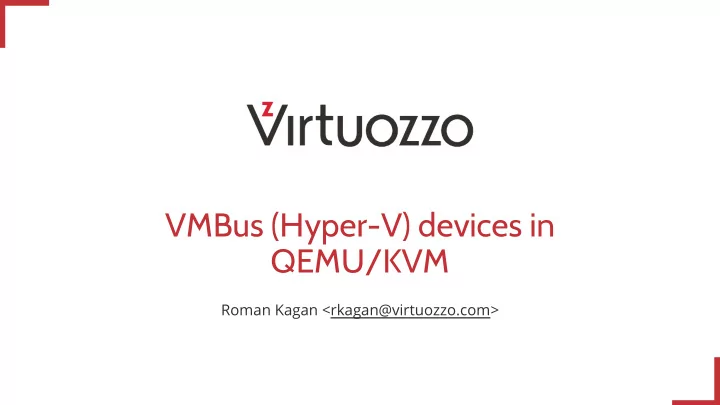

VMBus (Hyper-V) devices in QEMU/KVM Roman Kagan <rkagan@virtuozzo.com>
About me • with Virtuozzo (formerly Parallels, formerly SWSoft) since 2005 • in different roles including large-scale automated testing development for • container and hypervisor proprietary Parallels hypervisor development • now: opensource QEMU/KVM-based Virtuozzo • hypervisor development
Disclaimers ➢ all trademarks are the property of their respective owners ➢ the only authoritative and up-to-date documentation is the code
Outline 1. Motivation virtual h/w choice for Windows VM a. 2. Hyper-V / VMBus emulation layers & components a. implementation details b. implementation status c. 3. Summary & outlook
Motivation ? wanted: • performance KVM KVM • easy to deploy QEMU KVM QEMU KVM CPU ● QEMU • support QEMU RAM ● HDD ● … ● W i n d o w s XXXX-XXXX-XXXX
Choice #1: h/w emulation VM W ✔ easy to deploy i n d o w ✔ support s ✘ performance e1000 IDE
Virtual machine ≠ physical machine physical machine : virtual machine : • all CPU and RAM is • can be preempted yours • can be swapped out • timing is (somewhat) • many things become predictable expensive (APIC, I/O, MSRs, etc ) answer: paravirtualization
Choice #2: VirtIO W VM i WindowsGuestDrivers n d o w s (aka virtio-win) ✔ performance virtio virtio d r i v e r ✘ easy to deploy net scsi s ✘ support
What’s wrong with virtio-win? Certified? WHQL ⇒ SVVP ⇒ support No… GPL � WHQL in order to ship it, you need to own it
Choice #3: Hyper-V emulation VM W ✔ performance i n d o w ✔ easy to deploy s ✔ support VMBus VMBus � sounds like a plan! � net strg
Hyper-V: how to? 1. Microsoft docs on GitHub 2. Linux guest code for Hyper-V (everything under CONFIG_HYPERV ) 3. trial & error e.g. things work with Linux hyperv guest but break • with Windows guest
Hyper-V paravirtualization • previously implemented enlightenments • management MSRs • synthetic interrupt controller • timers • hypercalls • VMBus • devices
Hyper-V preexisting enlightenments • management MSRs • GUEST_OS_ID • VP_INDEX • hypercall infrastructure • scheduler NOTIFY_LONG_SPIN_WAIT hypercall • • LAPIC MSR access to EOI / ICR / TPR • APIC assist page (aka pvEOI) •
Hyper-V management MSRs • reset • panic CRASH_CTL , CRASH_P0…P3 — BSOD info • • VP_RUNTIME
Hyper-V clocks partition reference time : monotonic clock in 100ns ticks since boot • time reference counter: rdmsr HV_X64_MSR_TIME_REF_COUNT 1 vmexit / clock read • no hardware requirements •
Hyper-V clocks (cont’d) • TSC reference page: similar to kvm_clock time = (scale * tsc) >> 64 + offset no vmexits • invariant TSC req’d • one per VM • read consistency via seqcount • seqcount == 0 ⇒ fall-back to time ref count • no seqlock semantics ⇒ use fall-back on updates ⇒ • monotonicity with time ref count req’d
Hyper-V SynIC (synthetic interrupt controller) • LAPIC extension managed via MSRs • 16 SINT’s per vCPU • AutoEOI support incompatible with APICv • • KVM_IRQ_ROUTING_HV_SINT GSI → vCPU#, SINT# • • irqfd support • KVM_EXIT_HYPERV(SYNIC) on MSR access
Hyper-V SynIC — message page 4096 bytes SINT0 … SINTx … SINT15 256 bytes header payload msg_type hypervisor post: guest receive: msg_type: CAS read payload • • msg_type: atomic • TYPE_NONE→TYPE_NNN write payload • TYPE_NNN→TYPE_NONE deliver SINTx EOI or EOM ⇒ eventfd • •
Hyper-V SynIC — event flags page 4096 bytes SINT0 … SINTx … SINT15 256 bytes 2048 event flags (bits) hypervisor signal: guest receive: event flag: CAS 0→1 event flag: atomic 1→0 • • deliver SINTx EOI or EOM ⇒ eventfd • •
Hyper-V timers • per vCPU: 4 timers × 2 MSRs (config, count) • in partition reference time • SynIC messages HVMSG_TIMER_EXPIRED expiration time • delivery time • • in KVM ⇒ first to take message slot • periodic / one-shot • lazy (= discard ) / period modulation (= slew )
Hyper-V hypercalls extend existing implementation in KVM: • new hypercalls • HVCALL_POST_MESSAGE • HVCALL_SIGNAL_EVENT • pass-through to userspace • KVM_EXIT_HYPERV(HCALL) • stub implementation in QEMU
Hyper-V VMBus • announced via ACPI • host–guest messaging connection host → guest: SINT & message page • guest → host: POST_MESSAGE hypercall • • used to negotiate version and parameters • discover & setup devices • setup channels •
Hyper-V VMBus channel entity similar to VirtIO virtqueue • descriptor rings akin to VirtIO vrings • 1+ per device • signaling: host → guest: SINT & event flags page • guest → host: SIGNAL_EVENT hypercall • • used for data transfer
Hyper-V VMBus devices • util (shutdown, heartbeat, timesync, VSS, etc ) • storage • net • balloon
Firmware support needed to boot off Hyper-V storage or network • SeaBios • OVMF ⇒ port over from kernel
Summary • Hyper-V / VMBus emulation is a viable solution to make Windows guests’ life on QEMU/KVM easier • we have the groundwork in KVM and QEMU mostly complete • the actual VMBus devices implementation is being worked on
Outlook • performance measurement & tuning • vhost integration • AF_VSOCK transport • event logging • debugging • more devices input • video •
Recommend
More recommend